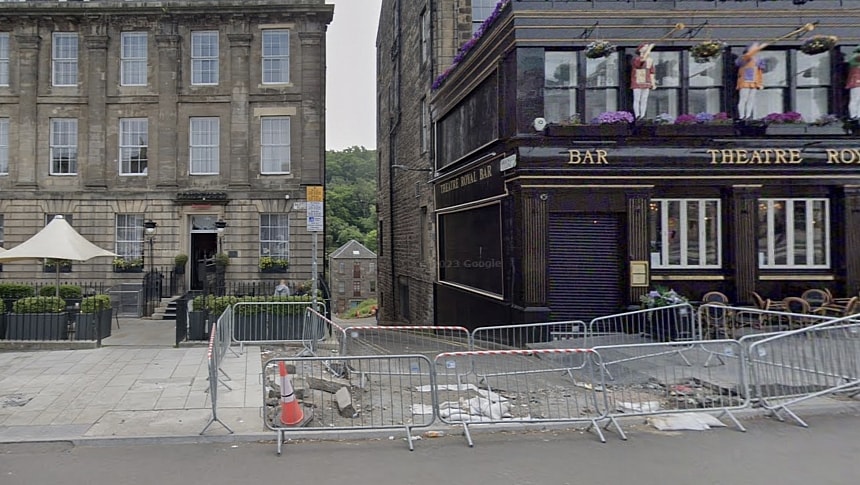You'd think drivers wouldn't attempt such a dangerous stunt like going down a set of city steps, but as everybody learned the hard way, many people follow Google Maps blindly and do whatever the app says.
It's how at least four motorists ended up stuck in Edinburgh on the new stairs installed last year on Greenside Lane. Navigation apps, like Google Maps and Apple Maps, offered the old maps and directions, telling drivers to make a turn over the bike lane and the pavement.
Four people attempted the stunt, eventually getting stuck on the stairs and calling the emergency teams for help.
The Edinburgh authorities told drivers to use common sense, not Google Maps, but because users can't give up on navigation apps, they had no option but to adopt new safety measures to protect pedestrians.
The city officials explain that the new steps are very busy, so a car that attempts to go down the steps could be a stunt with serious consequences.
The authorities claim they have already contacted Google Maps and Apple Maps to update the directions and remove the footpath from their routing engines. Theoretically, both apps should now offer correct guidance, but the Edinburgh officials don't want to take any risks. As a result, they'll install barriers to prevent drivers from attempting to go down the stairs.
The barriers will be installed temporarily, at least until drivers get to know the area and understand they're not supposed to make a turn on the stairs. Councilor Scott Arthur, transport and environment convener, says the barriers are the only solution because drivers seem to lack common sense, blindly trusting whatever the navigation app says.
The safety measures enforced by authorities highlight a problem becoming more widespread worldwide. Drivers rely on Google Maps, Apple Maps, Waze, and other navigation software for every second they spend behind the wheel, especially when going to an unfamiliar destination. They typically ignore road signs and pay attention to satellite navigation exclusively, sometimes ending up in dangerous and ridiculous situations.
Authorities call for using common sense, especially because navigation apps can't always be up-to-date with what's happening on the road. A tiny error on the maps can send drivers to the middle of nowhere, leaving them stranded without anyone to help them.
It happened several times in the past, including a few months ago when a dozen drivers left the interstate to use a desert path as an alternative route suggested by Google Maps. The unpaved road looked dangerous, but the drivers still used it, eventually deciding to return after they reached a dead-end and their cars suffered damages requiring towing. Google Maps only corrected the route after the case went viral, but common sense would have told drivers to stay on the paved route and avoid going through the desert no matter what.
Four people attempted the stunt, eventually getting stuck on the stairs and calling the emergency teams for help.
The Edinburgh authorities told drivers to use common sense, not Google Maps, but because users can't give up on navigation apps, they had no option but to adopt new safety measures to protect pedestrians.
The city officials explain that the new steps are very busy, so a car that attempts to go down the steps could be a stunt with serious consequences.
The authorities claim they have already contacted Google Maps and Apple Maps to update the directions and remove the footpath from their routing engines. Theoretically, both apps should now offer correct guidance, but the Edinburgh officials don't want to take any risks. As a result, they'll install barriers to prevent drivers from attempting to go down the stairs.
The barriers will be installed temporarily, at least until drivers get to know the area and understand they're not supposed to make a turn on the stairs. Councilor Scott Arthur, transport and environment convener, says the barriers are the only solution because drivers seem to lack common sense, blindly trusting whatever the navigation app says.
The safety measures enforced by authorities highlight a problem becoming more widespread worldwide. Drivers rely on Google Maps, Apple Maps, Waze, and other navigation software for every second they spend behind the wheel, especially when going to an unfamiliar destination. They typically ignore road signs and pay attention to satellite navigation exclusively, sometimes ending up in dangerous and ridiculous situations.
Authorities call for using common sense, especially because navigation apps can't always be up-to-date with what's happening on the road. A tiny error on the maps can send drivers to the middle of nowhere, leaving them stranded without anyone to help them.
It happened several times in the past, including a few months ago when a dozen drivers left the interstate to use a desert path as an alternative route suggested by Google Maps. The unpaved road looked dangerous, but the drivers still used it, eventually deciding to return after they reached a dead-end and their cars suffered damages requiring towing. Google Maps only corrected the route after the case went viral, but common sense would have told drivers to stay on the paved route and avoid going through the desert no matter what.
















